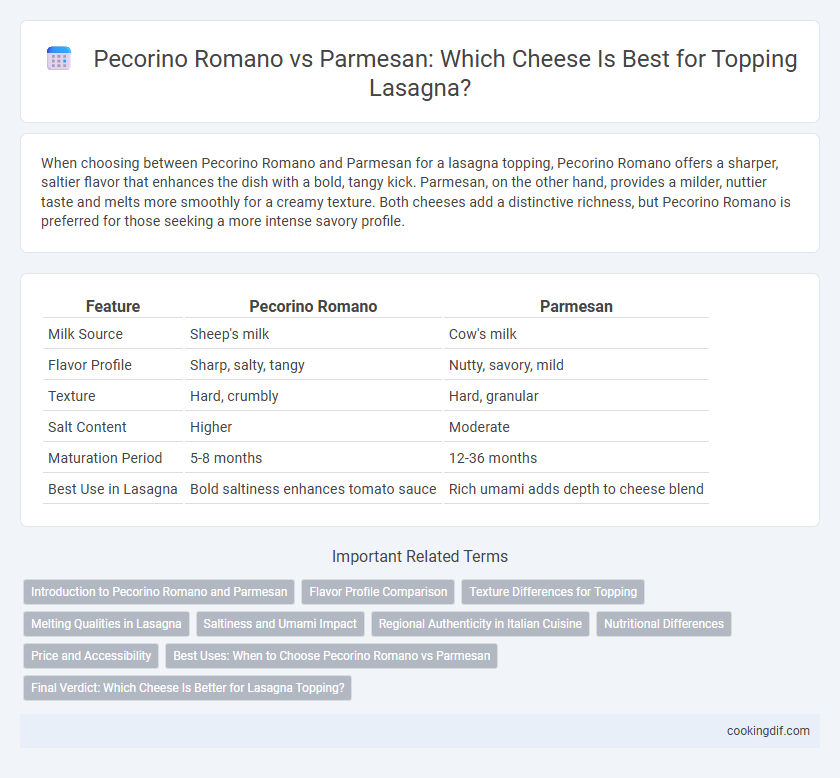When choosing between Pecorino Romano and Parmesan for a lasagna topping, Pecorino Romano offers a sharper, saltier flavor that enhances the dish with a bold, tangy kick. Parmesan, on the other hand, provides a milder, nuttier taste and melts more smoothly for a creamy texture. Both cheeses add a distinctive richness, but Pecorino Romano is preferred for those seeking a more intense savory profile.
Table of Comparison
| Feature | Pecorino Romano | Parmesan |
|---|---|---|
| Milk Source | Sheep's milk | Cow's milk |
| Flavor Profile | Sharp, salty, tangy | Nutty, savory, mild |
| Texture | Hard, crumbly | Hard, granular |
| Salt Content | Higher | Moderate |
| Maturation Period | 5-8 months | 12-36 months |
| Best Use in Lasagna | Bold saltiness enhances tomato sauce | Rich umami adds depth to cheese blend |
Introduction to Pecorino Romano and Parmesan
Pecorino Romano is a hard, salty Italian cheese made from sheep's milk, known for its sharp and tangy flavor that enhances the richness of lasagna. Parmesan, or Parmigiano-Reggiano, is a cow's milk cheese with a nutty, savory profile and granular texture, prized for its umami depth and meltability. Choosing between Pecorino Romano and Parmesan for lasagna topping depends on whether a bold, salty kick or a mellow, complex flavor is desired to complement the tomato sauce and ricotta layers.
Flavor Profile Comparison
Pecorino Romano offers a sharp, salty flavor with a tangy, robust profile that intensifies the savory notes of lasagna, while Parmesan delivers a nuttier, milder taste with a hint of sweetness that enhances the dish's richness without overpowering it. The higher salt content in Pecorino Romano provides a bold contrast to the tomato sauce, creating a more pronounced depth of flavor, whereas Parmesan's aged creaminess blends smoothly into the layers, adding subtle umami complexity. Choosing between Pecorino Romano and Parmesan depends on whether the desired lasagna topping emphasizes piquant sharpness or balanced, mellow savoriness.
Texture Differences for Topping
Pecorino Romano offers a sharper, saltier profile with a grainier and coarser texture compared to Parmesan, creating a bold, crunchy topping for lasagna. Parmesan, known for its nuttier, milder taste, has a finer, more crumbly texture that melts smoothly, providing a delicate, creamy finish. Choosing between Pecorino Romano and Parmesan depends on whether a sharper bite or a smoother melt is preferred for the lasagna cheese topping.
Melting Qualities in Lasagna
Pecorino Romano offers a sharp, salty flavor with a firmer texture that melts less uniformly in lasagna, creating a distinct, slightly grainy topping. Parmesan provides a creamier melt and smoother texture, enhancing the overall cohesion of cheese layers. For a balanced lasagna cheese topping, Parmesan's superior melting qualities contribute to a more consistent, richly integrated finish compared to Pecorino Romano.
Saltiness and Umami Impact
Pecorino Romano delivers a sharper, saltier profile than Parmesan, enhancing lasagna with robust saltiness that intensifies every layer. Parmesan offers a milder salt content and a complex umami richness that melts smoothly into the sauce. Choosing Pecorino Romano elevates bold, savory notes, while Parmesan balances saltiness with a creamy, umami depth for a harmonious cheese topping.
Regional Authenticity in Italian Cuisine
Pecorino Romano, a sharp, salty sheep's milk cheese from Lazio, Sardinia, and Tuscany, provides a robust flavor traditionally preferred in Roman-style lasagna. Parmesan, or Parmigiano-Reggiano, originating from Emilia-Romagna and Lombardia, offers a nuttier, milder finish suited to northern Italian variations. Choosing Pecorino Romano emphasizes regional authenticity for classic Roman recipes, while Parmesan aligns with broader Italian culinary preferences.
Nutritional Differences
Pecorino Romano contains higher sodium levels compared to Parmesan, making it a saltier choice for lasagna topping. Parmesan offers a richer source of calcium and protein, supporting bone health and muscle maintenance. Both cheeses offer distinct flavor profiles, but nutrient-wise, Parmesan provides a lower sodium option with added nutritional benefits.
Price and Accessibility
Pecorino Romano tends to be more expensive and less widely available than Parmesan, which is commonly found in most grocery stores and online retailers. Parmesan offers a more affordable option for a cheese topping in lasagna, making it accessible to a broader range of home cooks. The distinct sharpness of Pecorino Romano justifies its higher price, but Parmesan remains the go-to choice for its balance of flavor, cost, and availability.
Best Uses: When to Choose Pecorino Romano vs Parmesan
Pecorino Romano is best used in lasagna recipes that call for a sharper, saltier cheese flavor, enhancing robust tomato sauces and rich meat fillings. Parmesan is ideal for a milder, nuttier taste that complements creamy bechamel layers and vegetable lasagnas. Choosing between the two depends on whether a bolder or subtler cheese profile is desired to balance the dish's other ingredients.
Final Verdict: Which Cheese Is Better for Lasagna Topping?
Pecorino Romano offers a sharper, saltier flavor that enhances the savory profile of lasagna, while Parmesan provides a nuttier, milder taste that melts smoothly into the layers. Parmesan's balanced flavor and creamy texture make it the preferred choice for a classic, rich lasagna topping, whereas Pecorino Romano is ideal for those seeking a bold, tangy finish. For the best lasagna topping, Parmesan is generally favored for its ability to complement the dish's overall harmony without overpowering other ingredients.
Pecorino Romano vs Parmesan for cheese topping Infographic

 cookingdif.com
cookingdif.com